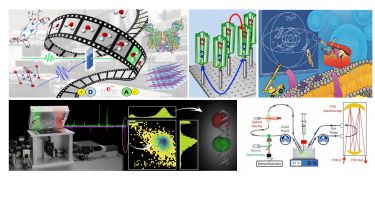Light-matter interactions
We are a vibrant group of researchers who are experts in how light interacts with molecules.

We bring together research from chemistry, physics, and biology to understand these phenomena and explore their impact.
In our labs, we develop cutting-edge techniques to observe how light affects molecules and biological systems at the most fundamental level. These methods are incredibly fast and sensitive, allowing us to capture the incredibly rapid events that occur when light interacts with matter. We also develop innovative tools to analyse the structure and behavior of molecules, biomolecules, and materials. And we're constantly searching for new ways to control and manipulate chemical reactions using light.
Theory is an essential part of our work. We use theoretical models and powerful computers to understand the results of our experiments and to develop new hypotheses that can guide future research.
We thrive on collaboration, both within our university and with researchers around the world. By working together, we can push the boundaries of our knowledge and make significant advancements in our understanding of light-driven processes.
Major themes include:
- Ultra-fast light matter interactions: charge and energy transfer in molecular systems and biomolecules, artificial photosynthesis and light-harvesting, photocatalysis
- Biophysical chemistry: single-molecule spectroscopy and microscopy, energy transfer in molecular systems, photoinduced proton transfer in proteins, super photoacids
- Surfaces and materials: plasmonics, surface spectroscopy, bionanotechnology, photonics
- Applied spectroscopy: development of new analytical spectroscopic techniques and their applications, to study the metabolism of bacteria, and sensing of nutrients in soils.
- Photodynamic therapy
- Theoretical and computational studies of Materials Chemistry, Astrochemistry, Intermolecular Forces, Photochemistry, Photocatalysis, Machine learning
Methods
- Ultrafast laser spectroscopy
- Ultrasensitive techniques: single-molecule FRET, cavity ring-down spectroscopy, Raman spectroscopy
- Imaging techniques: Nanolithography, surface patterning, AFM, Molecular photonics breadboards, Optical Coherence Tomography (OCT)
- FLIM and phosphorescence lifetime imaging microscopy in cells and tissues.
- Developing new theories and methods for electronic structure, graph theory, and quantum dynamics calculations with a particular emphasis on the development of parallel and GPU-based methods.
Members
- Professor Julia Weinstein (Cluster lead)
- Professor Nadav Amdursky
- Dr Adrien Chauvet
- Dr Timothy Craggs
- Professor Graham Leggett
- Dr Michael Hippler
- Professor Anthony Meijer
- Dr J. Grant Hill
- Dr Natalia Martsinovich
- Emeritus Professor Barry Pickup
- Emeritus Professor Patrick Fowler
Research facilities
- Lord Porter Ultrafast Laser Spectroscopy Laboratory
- Wolfson Light Microscopy Facility
- SMALL
- Open Source Single-Molecule FRET
